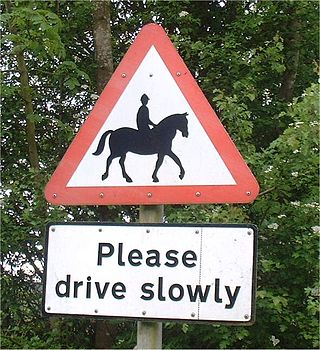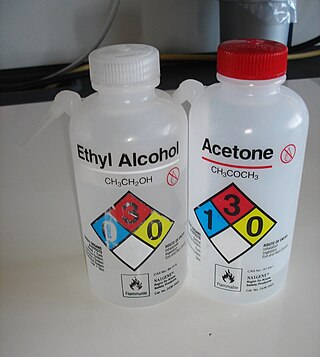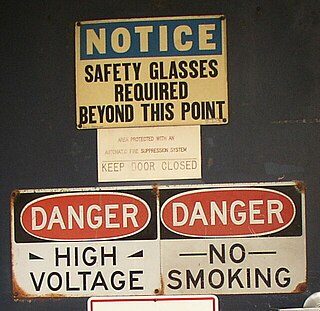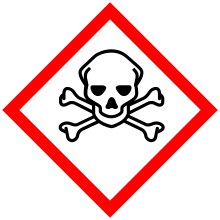
A biological hazard, or biohazard, is a biological substance that poses a threat to the health of living organisms, primarily humans. This could include a sample of a microorganism, virus or toxin that can adversely affect human health. A biohazard could also be a substance harmful to other living beings.

A pictogram is a graphical symbol that conveys meaning through its visual resemblance to a physical object. Pictograms are used in systems of writing and visual communication. A pictography is a writing system which uses pictograms. Some pictograms, such as hazard pictograms, may be elements of formal languages.
Ionizing radiation (US) (or ionising radiation [UK]), including nuclear radiation, consists of subatomic particles or electromagnetic waves that have sufficient energy to ionize atoms or molecules by detaching electrons from them. Some particles can travel up to 99% of the speed of light, and the electromagnetic waves are on the high-energy portion of the electromagnetic spectrum.
A skull and crossbones is a symbol consisting of a human skull and two long bones crossed together under or behind the skull. The design originated in the Late Middle Ages as a symbol of death and especially as a memento mori on tombstones.

Radioactive contamination, also called radiological pollution, is the deposition of, or presence of radioactive substances on surfaces or within solids, liquids, or gases, where their presence is unintended or undesirable.

"NFPA 704: Standard System for the Identification of the Hazards of Materials for Emergency Response" is a standard maintained by the U.S.-based National Fire Protection Association. First "tentatively adopted as a guide" in 1960, and revised several times since then, it defines the "Safety Square" or "Fire Diamond" which is used to quickly and easily identify the risks posed by hazardous materials. This helps determine what, if any, special equipment should be used, procedures followed, or precautions taken during the initial stages of an emergency response. It is an internationally accepted safety standard, and is crucial while transporting chemicals.

Chemical hazards are typical of hazardous chemicals and hazardous materials in general. Exposure to certain chemicals can cause acute or long-term adverse health effects. Chemical hazards are usually classified separately from biological hazards (biohazards). Main classifications of chemical hazards include asphyxiants, corrosives, irritants, sensitizers, carcinogens, mutagens, teratogens, reactants, and flammables. In the workplace, exposure to chemical hazards is a type of occupational hazard. The use of protective personal equipment (PPE) may substantially reduce the risk of damage from contact with hazardous materials.

ADR, formally the Agreement of 30 September 1957 concerning the International Carriage of Dangerous Goods by Road is a 1957 United Nations treaty that governs transnational transport of hazardous materials. "ADR" is derived from the French name for the treaty: Accord relatif au transport international des marchandises Dangereuses par Route). Until 31 December 2020, the treaty was fully named European Agreement concerning the International Carriage of Dangerous Goods by Road. However, as the word "European" might have given the impression that the treaty was only open for accession to European states, an amendment was decided in the end of 2019.

The Globally Harmonized System of Classification and Labelling of Chemicals (GHS) is an internationally agreed-upon standard managed by the United Nations that was set up to replace the assortment of hazardous material classification and labelling schemes previously used around the world. Core elements of the GHS include standardized hazard testing criteria, universal warning pictograms, and safety data sheets which provide users of dangerous goods relevant information with consistent organization. The system acts as a complement to the UN numbered system of regulated hazardous material transport. Implementation is managed through the UN Secretariat. Although adoption has taken time, as of 2017, the system has been enacted to significant extents in most major countries of the world. This includes the European Union, which has implemented the United Nations' GHS into EU law as the CLP Regulation, and United States Occupational Safety and Health Administration standards.
Hazard statements form part of the Globally Harmonized System of Classification and Labelling of Chemicals (GHS). They are intended to form a set of standardized phrases about the hazards of chemical substances and mixtures that can be translated into different languages. As such, they serve the same purpose as the well-known R-phrases, which they are intended to replace.
Hazard pictograms form part of the international Globally Harmonized System of Classification and Labelling of Chemicals (GHS). Two sets of pictograms are included within the GHS: one for the labelling of containers and for workplace hazard warnings, and a second for use during the transport of dangerous goods. Either one or the other is chosen, depending on the target audience, but the two are not used together for the same hazard. The two sets of pictograms use the same symbols for the same hazards, although certain symbols are not required for transport pictograms. Transport pictograms come in wider variety of colors and may contain additional information such as a subcategory number.
European hazard symbols for chemicals are pictograms defined by the European Union for labelling chemical packaging and containers. They are standardised currently by the CLP/GHS classification.

ISO 21482 is a technical standard that specifies the design and usage of a "supplemental radiation warning symbol", a warning symbol intended to warn of the dangers of radiation hazards posed by sealed sources and encourage the viewer to get away from the source. The symbol's design was the result of a joint project between the International Atomic Energy Agency (IAEA) and International Organization for Standardization (ISO) in the early 2000s.

Barricade tape is brightly colored tape that is used to warn or catch the attention of passersby of an area or situation containing a possible hazard. It acts as a minor impediment to prevent accidental entrance to that area or situation and as a result enhances general safety. Barricade tape is also known as construction tape or barrier tape, or in reference to the safety hazard involved as caution tape, warning tape, danger tape or hazard tape. When used by police, the tape is named police tape.

In the process industry, chemical industry, manufacturing industry, and other commercial and industrial contexts, pipe marking is used to identify the contents, properties and flow direction of fluids in piping. It is typically carried out by marking piping through labels and color codes. Pipe marking helps personnel and fire response teams identify the correct pipes for operational, maintenance or emergency response purposes.
ISO 7010 is an International Organization for Standardization technical standard for graphical hazard symbols on hazard and safety signs, including those indicating emergency exits. It uses colours and principles set out in ISO 3864 for these symbols, and is intended to provide "safety information that relies as little as possible on the use of words to achieve understanding."

Safety signs are a type of sign designed to warn of hazards, indicate mandatory actions or required use of Personal protective equipment, prohibit actions or objects, identify the location of firefighting or safety equipment, or marking of exit routes.

Workplace safety standards are sets of standards developed with the goal of reducing risk from occupational hazards.

ANSI Z35.1 the Specifications for Accident Prevention Signs, was an American standard that dictated the layout, colors and wording of safety signs in the United States. The standard is the first American standard that made specific demands for the design, construction, and placement of safety signage in industrial environments. The first edition was published in January 1941, and the fourth and final edition in November 1972. Changes in societal needs of signage, and further research into signage would result in the establishment of a new committee, the ANSI Z535 Committee on Safety Signs and Colors, combining the separate committees of Z35.1 - Specifications for Accident Prevention Signs, Z35.2 - Specifications for Accident Prevention Tags, and Z53 - Marking Physical Hazards Safety Color Code, resulting in a new combined standard, ANSI Z535.

































